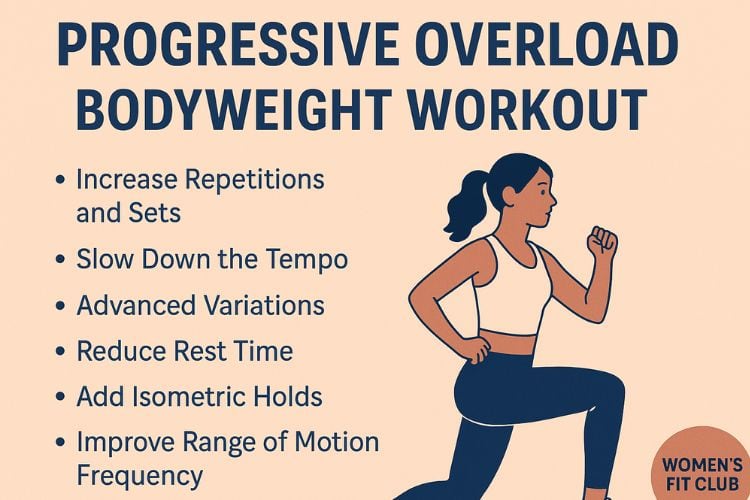Sign up for workout ideas, training advice, reviews of the latest gear and more.






If you’ve ever thought building muscle requires heavy dumbbells or expensive gym equipment, think again. The progressive overload principle—one of the most effective training methods—can be applied using just your body weight. This guide will walk you through everything you need to know about progressive overload bodyweight workouts, including how to apply the principle, sample routines, and strategies to keep progressing long-term.
Progressive overload is the process of gradually increasing the stress placed on your muscles during training. This stress forces your body to adapt—by becoming stronger, more powerful, and more efficient.
When you lift heavier weights, perform more repetitions, or add intensity over time, your muscles are challenged beyond their comfort zone. The body responds by repairing and strengthening the muscle fibers to handle future loads. This same principle applies to bodyweight training—you don’t need weights to achieve overload; you just need smart progression.
Without progressive overload, your body will adapt and hit a plateau. Even if you’re consistent, you won’t keep seeing progress unless the challenge increases. Progressive overload ensures:
By mastering the principle, you’ll make simple bodyweight exercises—like push-ups, squats, and planks—feel brand-new again.
The most straightforward way to apply progressive overload with bodyweight exercises is by increasing the total work volume.
For example:
This gradual increase keeps your muscles working harder over time.
Tempo manipulation is a secret weapon for progression. Slowing down the movement increases time under tension (TUT)—how long your muscles are working during each rep.
Try a 3-second lowering phase on your squats or push-ups. This engages more muscle fibers and enhances strength and control.
Once an exercise becomes easy, make it more challenging by progressing to a harder version.
Examples include:
Each progression demands greater balance, coordination, and strength.
Another effective way to increase intensity is by reducing rest between sets. For instance, shorten your rest from 60 seconds to 30 seconds while maintaining reps and form. This elevates your heart rate, improving endurance and calorie burn.
Isometric training involves holding a position to build muscular endurance and strength.
Examples:
Adding static holds increases muscle activation and mental toughness.
Increasing your range of motion makes an exercise more demanding. For instance:
These small changes engage more muscle fibers and boost flexibility.
Performing workouts more frequently (while maintaining recovery) can also drive progression. For example, move from 2 to 3 training sessions per week to accelerate adaptation.
You’ll develop genuine strength through control, stability, and coordination—not just lifting heavier weights.
Bodyweight training improves mind-muscle connection, balance, and mobility. You’ll learn to move efficiently and safely in everyday life.
No gym? No problem. These workouts can be done anywhere—at home, outdoors, or while traveling.
Without external weights, the risk of overloading joints or tendons is lower. You can focus on perfecting form and movement mechanics.
Progressive overload training tones and defines the entire body while building real-world functional fitness.

Below is a 4-week progression plan to help you apply the principle effectively. Perform this routine 3–4 times a week, allowing one rest day between sessions.
Before any workout, prime your muscles and joints:
Goal: Establish proper form and baseline endurance.
Circuit (3 Rounds):
Rest 60 seconds between rounds.
Focus on control and smooth tempo.
Goal: Add reps and improve consistency.
Circuit (4 Rounds):
Rest 45 seconds between rounds.
Tempo: 2-seconds down, 1-second up.
Goal: Challenge muscles with harder variations.
Circuit (4 Rounds):
Rest 30 seconds between rounds.
Add 2-second isometric holds at the bottom of each push-up and squat.
Goal: Combine explosive and controlled movements.
Circuit (5 Rounds):
Rest 30 seconds between rounds.
This week emphasizes explosive power and maximum control for ultimate overload.
After finishing, take time to stretch and recover:
Consistency and data tracking are crucial for progressive overload. Use a simple fitness journal or app to record:
By monitoring these details, you can identify when it’s time to increase intensity or modify the exercises.
Progress doesn’t mean rushing through reps. Prioritize proper form to prevent injuries and ensure each muscle is effectively engaged.
Muscles grow during rest—not while training. Schedule at least one or two recovery days per week to allow adaptation and repair.
Repeating the same routine for months can lead to plateaus. Every 4–6 weeks, introduce new variations or change your exercise order to maintain challenge and interest.
More isn’t always better. Overtraining can lead to fatigue, decreased performance, and injuries. Listen to your body and rest when needed.
Even the best workout program won’t yield results without proper fuel and rest. To support muscle growth and recovery:
Applying progressive overload through bodyweight training develops not only a strong physique but also discipline and resilience. Over time, you’ll notice improvements in:
The best part? You can maintain this routine for life. It requires no equipment, minimal space, and can evolve endlessly.
Progressive overload is the foundation of continuous improvement in fitness. When applied to bodyweight training, it unlocks the power of your own body as resistance. Whether you’re a beginner or advanced athlete, the key is to challenge yourself gradually, stay consistent, and track progress.
Start with the sample plan above, and remember—your only limit is how far you’re willing to push your potential.
Stay up to date on the latest women’s health, fitness and lifestyle trends and tips.